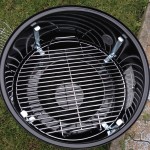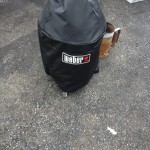Did my inaugural cook in the 14.5″ Weber Smokey Mountain my lifepartner is giving me for my birthday (she knows I don’t like surprises).
Will probably post some written notes of my smoking endeavours, at some point. In the meantime, some pictures documenting the whole thing.
Category Archives: Placeholders
Wearable Hub: Getting the Ball Rolling
Statement
After years of hype, wearable devices are happening. What wearable computing lacks is a way to integrate devices into a broader system.
Disclaimer/Disclosure/Warning
- For the past two months or so, I’ve been taking notes about this “wearable hub” idea (started around CES’s time, as wearable devices like the Pebble and Google Glass were discussed with more intensity). At this point, I have over 3000 words in notes, which probably means that I’d have enough material for a long essay. This post is just a way to release a few ideas and to “think aloud” about what wearables may mean.
- Some of these notes have to do with the fact that I started using a few wearable devices to monitor my activities, after a health issue pushed me to start doing some exercise.
- I’m not a technologist nor do I play one on this blog. I’m primarily an ethnographer, with diverse interests in technology and its implications for human beings. I do research on technological appropriation and some of the course I teach relate to the social dimensions of technology. Some of the approaches to technology that I discuss in those courses relate to constructionism and Actor-Network Theory.
- I consider myself a “geek ethnographer” in the sense that I take part in geek culture (and have come out as a geek) but I’m also an outsider to geekdom.
- Contrary to the likes of McLuhan, Carr, and Morozov, my perspective on technology and society is non-deterministic. The way I use them, “implication” and “affordance” aren’t about causal effects or, even, about direct connections. I’m not saying that society is causing technology to appear nor am I proposing a line from tools to social impacts. Technology and society are in a complex system.
- Further, my approach isn’t predictive. I’m not saying what will happen based on technological advances nor am I saying what technology will appear. I’m thinking about the meaning of technology in an intersubjective way.
- My personal attitude on tools and gadgets is rather ambivalent. This becomes clear as I go back and forth between techno-enthusiastic contexts (where I can almost appear like a Luddite) and techno-skeptical contexts (where some might label me as a gadget freak). I integrate a number of tools in my life but I can be quite wary about them.
- I’m not wedded to the ideas I’m putting forth, here. They’re just broad musings of what might be. More than anything, I hope to generate thoughtful discussion. That’s why I start this post with a broad statement (not my usual style).
- Of course, I know that other people have had similar ideas and I know that a concept of “wearable hub” already exists. It’s obvious enough that it’s one of these things which can be invented independently.
From Wearables to Hubs
Back in the 1990s, “wearable computing” became something of a futuristic buzzword, often having to do with articles of clothing. There have been many experiments and prototypes converging on an idea that we would, one day, be able to wear something resembling a full computer. Meanwhile, “personal digital assistants” became something of a niche product and embedded systems became an important dimension of car manufacturing.
Fast-forward to 2007, when a significant shift in the use of smartphones occurred. Smartphones existed before that time, but their usages, meanings, and positions in the public discourse changed quite radically around the time of the iPhone’s release. Not that the iPhone itself “caused a smartphone revolution” or that smartphone adoption suddenly reached a “tipping point”. I conceive of this shift as a complex interplay between society and tools. Not only more Kuhn than Popper, but more Latour than Kurzweil.
Smartphones, it may be argued, “happened”.
Without being described as “wearable devices”, smartphones started playing some of the functions people might have assigned to wearable devices. The move was subtle enough that Limor Fried recently described it as a realization she’s been having. Some tech enthusiasts may be designing location-aware purses and heads-up displays in the form of glasses. Smartphones are already doing a lot of the things wearables were supposed to do. Many people “wear” smartphones at most times during their waking lives and these Internet-connected devices are full of sensors. With the proliferation of cases, one might even perceive some of them as fashion accessories, like watches and sunglasses.
Where smartphones become more interesting, in terms of wearable computing, is as de facto wearable hubs.
My Wearable Devices
Which brings me to mention the four sensors I’ve been using more extensively during the past two months:
Yes, these all have to do with fitness (and there’s quite a bit of overlap between them). And, yes, I started using them a few days after the New Year. But it’s not about holiday gifts or New Year’s resolutions. I’ve had some of these devices for a while and decided to use them after consulting with a physician about hypertension. Not only have they helped me quite a bit in solving some health issues, but these devices got me to think.
(I carry several other things with me at most times. Some of my favourites include Tenqa REMXD Bluetooth headphones and the LiveScribe echo smartpen.)
One aspect is that they’re all about the so-called “quantified self”. As a qualitative researcher, I tend to be skeptical of quants. In this case, though, the stats I’m collecting about myself fit with my qualitative approach. Along with quantitative data from these devices, I’ve started collecting qualitative data about my life. The next step is to integrate all those data points automatically.
These sensors are also connected to “gamification”, a tendency I find worrisome, preferring playfulness. Though game mechanics are applied to the use of these sensors, I choose to rely on my intrinsic motivation, not paying much attention to scores and badges.
But the part which pushed me to start taking the most notes was that all these sensors connect with my iOS ()and Android) devices. And this is where the “wearable hub” comes into play. None of these devices is autonomous. They’re all part of my personal “arsenal”, the equipment I have on my me on most occasions. Though there are many similarities between them, they still serve different purposes, which are much more limited than those “wearable computers” might have been expected to serve. Without a central device serving as a type of “hub”, these sensors wouldn’t be very useful. This “hub” needs not be a smartphone, despite the fact that, by default, smartphones are taken to be the key piece in this kind of setup.
In my personal scenario, I do use a smartphone as a hub. But I also use tablets. And I could easily use an existing device of another type (say, an iPod touch), or even a new type of device meant to serve as a wearable hub. Smartphones’ “hub” affordances aren’t exclusive.
From Digital Hub to Wearable Hub
Most of the devices which would likely serve as hubs for wearable sensors can be described as “Post-PC”. They’re clearly “personal” and they’re arguably “computers”. Yet they’re significantly different from the “Personal Computers” which have been so important at the end of last century (desktop and laptop computers not used as servers, regardless of the OS they run).
Wearability is a key point, here. But it’s not just a matter of weight or form factor. A wearable hub needs to be wireless in at least two important ways: independent from a power source and connected to other devices through radio waves. The fact that they’re worn at all times also implies a certain degree of integration with other things carried throughout the day (wallets, purses, backpacks, pockets…). These devices may also be more “personal” than PCs because they may be more apparent and more amenable to customization than PCs.
Smartphones fit the bill as wearable hubs. Their form factors and battery life make them wearable enough. Bluetooth (or ANT+, Nike+, etc.) has been used to pair them wirelessly with sensors. Their connectivity to GPS and cellular networking as well as their audio and visual i/o can have interesting uses (mapping a walk, data updates during a commute, voice feedback…). And though they’re far from ubiquitous, smartphones have become quite common in key markets.
Part of the reason I keep thinking about “hubs” has to do with comments made in 2001 by then Apple CEO Steve Jobs about the “digital lifestyle” age in “PC evolution” (video of Jobs’s presentation; as an anthropologist, I’ll refrain from commenting on the evolutionary analogies):
We believe the PC, or more… importantly, the Mac can become the “digital hub” of our emerging digital lifestyle, with the ability to add tremendous value to … other digital devices.
… like camcorders, portable media players, cellphones, digital cameras, handheld organizers, etc. (Though they weren’t mentioned, other peripherals like printers and webcams also connect to PCs.)
The PC was thus going to serve as a hub, “not only adding value to these devices but interconnecting them, as well”.
At the time, key PC affordances which distinguished them from those other digital devices:
- Big screen affording more complex user interfaces
- Large, inexpensive hard disk storage
- Burning DVDs and CDs
- Internet connectivity, especially broadband
- Running complex applications (including media processing software like the iLife suite)
Though Jobs pinpointed iLife applications as the basis for this “digital hub” vision, it sounds like FireWire was meant to be an even more important part of this vision. Of course, USB has supplanted FireWire in most use cases. It’s interesting, then, to notice that Apple only recently started shipping Macs with USB 3. In fact, DVD burning is absent from recent Macs. In 2001, the Mac might have been at the forefront of this “digital lifestyle” age. In 2013, the Mac has moved away from its role as “digital hub”.
In the meantime, the iPhone has become one of the best known examples of what I’m calling “wearable hubs”. It has a small screen and small, expensive storage (by today’s standards). It also can’t burn DVDs. But it does have nearly-ubiquitous Internet connectivity and can run fairly complex applications, some of which are adapted from the iLife suite. And though it does have wired connectivity (through Lightning or the “dock connector”), its main hub affordances have to do with Bluetooth.
It’s interesting to note that the same Steve Jobs, who used the “digital hub” concept to explain that the PC wasn’t dead in 2001, is partly responsible for popularizing the concept of “post-PC devices” six years later. One might perceive hypocrisy in this much delayed apparent flip-flop. On the other hand, Steve Jobs’s 2007 comments (video) were somewhat nuanced, as to the role of post-PC devices. What’s more interesting, though, is to think about the implications of the shift between two views of digital devices, regardless of Apple’s position through that shift.
Some post-PC devices (including the iPhone, until quite recently) do require a connection to a PC. In this sense, a smartphone might maintain its position with regards to the PC as digital hub. Yet, some of those devices are used independently of PCs, including by some people who never owned PCs.
Post-Smartphone Hubs
It’s possible to imagine a wearable hub outside of the smartphone (and tablet) paradigm. While smartphones are a convenient way to interconnect wearables, their hub-related affordances still sound limited: they lack large displays and their storage space is quite expensive. Their battery life may also be something to consider in terms of serving as hubs. Their form factors make some sense, when functioning as phones. Yet they have little to do with their use as hubs.
Part of the realization, for me, came from the fact that I’ve been using a tablet as something of an untethered hub. Since I use Bluetooth headphones, I can listen to podcasts and music while my tablet is in my backpack without being entangled in a cable. Sounds trivial but it’s one of these affordances I find quite significant. Delegating music playing functions to my tablet relates in part to battery life and use of storage. The tablet’s display has no importance in this scenario. In fact, given some communication between devices, my smartphone could serve as a display for my tablet. So could a “smartwatch” or “smartglasses”.
The Body Hub
Which led me to think about other devices which would work as wearable hubs. I originally thought about backpackable and pocketable devices.
But a friend had a more striking idea:
@enkerli Undershirts will make a comeback, with a sensor mesh to monitor temp, heart rate, encourage you to move around more.
— A.J. Kandy (@AJKandy) February 26, 2013
Under Armour’s Recharge Energy Suit may be an extreme version of this, one which would fit nicely among things Cathi Bond likes to discuss with Nora Young on The Sniffer. Nora herself has been discussing wearables on her blog as well as on her radio show. Sure, part of this concept is quite futuristic. But a sensor mesh undershirt is a neat idea for several reasons.
- It’s easy to think of various sensors it may contain.
- Given its surface area, it could hold enough battery power to supplement other devices.
- It can be quite comfortable in cold weather and might even help diffuse heat in warmer climates.
- Though wearable, it needs not be visible.
- Thieves would probably have a hard time stealing it.
- Vibration and haptic feedback on the body can open interesting possibilities.
Not that it’s the perfect digital hub and I’m sure there are multiple objections to a connected undershirt (including issues with radio signals). But I find the idea rather fun to think, partly because it’s so far away from the use of phones, glasses, and watches as smart devices.
Another thing I find neat, and it may partly be a coincidence, is the very notion of a “mesh”.
The Wearable Mesh
Mesh networking is a neat concept, which generates more hype than practical uses. As an alternative to WiFi access points and cellular connectivity, it’s unclear that it may “take the world by storm”. But as a way to connect personal devices, it might have some potential. After all, as Bernard Benhamou recently pointed out on France Culture’s Place de la toile, the Internet of Things may not require always-on full-bandwith connectivity. Typically, wearable sensors use fairly little bandwidth or only use it for limited amounts of time. A wearable mesh could connect wearable devices to one another while also exchanging data through the Internet itself.
Or with local devices. Smart cities, near field communication, and digital appliances occupy interesting positions among widely-discussed tendencies in the tech world. They may all have something to do with wearable devices. For instance, data exchanged between transit systems and their users could go through wearable devices. And while mobile payment systems can work through smartphones and other cellphones, wallet functions can also be fulfilled by other wearable devices.
Alternative Futures
Which might provide an appropriate segue into the ambivalence I feel toward the “wearable hub” concept I’m describing. Though I propose these ideas as if I were enthusiastic about them, they all give me pause. As a big fan of critical thinking, I like to think about “what might be” to generate questions and discussions exposing a diversity of viewpoints about the future.
Mass media discussions about these issues tend to focus on such things as privacy, availability, norms, and usefulness. Google Glass has generated quite a bit of buzz about all four. Other wearables may mainly raise issues for one or two of these broad dimensions. But the broad domain of wearable computing raises a lot more issues.
Technology enthusiasts enjoy discussing issues through the dualism between dystopia and utopia. An obvious issue with this dualism is that humans disagree about the two categories. Simply put, one person’s dystopia can be another person’s utopia, not to mention the nuanced views of people who see complex relationships between values and social change.
In such a context, a sociologist’s reflex may be to ask about the implications of these diverse values and opinions. For instance:
- How do people construct these values?
- Who decides which values are more important?
- How might social groups cope with changes in values?
Discussing these issues and more, in a broad frame, might be quite useful. Some of the trickiest issues are raised after some changes in technology have already happened. From writing to cars, any technological context has unexpected implications. An ecological view of these implications could broaden the discussion.
I tend to like the concept of the “drift-off moment”, during which listeners (or readers) start thinking about the possibilities afforded a new tool (or concept). In the context of a sales pitch, the idea is that these possibilities are positive, a potential buyer is thinking about the ways she might use a newfangled device. But I also like the deeper process of thinking about all sorts of implications, regardless of their value.
So…
What might be the implications of a wearable hub?
Playful Living / Jouer notre existence
[En français plus bas…]
[youtube http://www.youtube.com/watch?v=Ivj6mx9dgqg]
Playing Next
This evening, I’ll be a guest at a public conversation on playfulness. This event is organized by University of the Streets Café, a community development program at Concordia University’s School of Extended Learning.
This post will serve as a placeholder.
The video above is something I did for Ignite Montreal, and contains much of what I’ve been thinking about, in terms of playfulness. The content can be found here, in different versions:
http://Playfulness.in/
Guests: Marleah Blom, Alexandre Enkerli
Moderator: Jimmy Ung
When: 7 p.m. – 9 p.m.
Where: Arts Café, 201 rue Fairmount Ouest, Montreal, Quebec, H2T 2M8
More info in this Facebook event: http://lar.me/playtalk .
Let’s have fun!
Mise au jeu
Je participerai ce soir à une conversation publique au sujet de l’amusement, organisée dans le cadre de L’Université autrement: dans les cafés (un programme de Concordia). Ça risque d’être amusant. (Plus d’infos ici: http://lar.me/jouons ).
Le 31 mars, j’étais à l’émission La Sphère de Radio-Canada, histoire de parler de ludification. J’y étais en compagnie d’un autre ethnographe, Sylvain Letellier de BeSpoke Montréal (croisé lors d’un 5à7 sur l’innovation ouverte), qui voit des bénéfices à la ludification en marketing et en recherche qualitative.
Conversation intéressante. Mon intention était de parler d’alternatives à la ludification, y compris le jeu ouvert et la conversation. Pas parlé de conversation (à part une mention de notre conversation de ce soir), mais j’ai pu amener le point au sujet du jeu ouvert, ce qui est déjà pas mal.
Pour la conversation publique:
Invités: Marleah Blom, Alexandre Enkerli
Modérateur: Jimmy Ung
Heure: 19h à 21h
Lieu: Arts Café, 201 rue Fairmount Ouest, Montreal, Quebec, H2T 2M8
Ethnic Diversity and Post-Nationalism
I normally don’t enjoy Quora. But I was just asked an anonymous question there which made me react. It’s close to the kind of question I get in my intro-level courses in sociology or anthropology, so I like to “do my job” of elucidating these issues.
Here’s the question:
Can there be such a thing as too much diversity?
Up until recently the rule for all immigrants was “When in Rome do as the Romans do.” This appears to have been replaced by “We’re not going to integrate but live as we did back home.”Is it possible that at some point diversity becomes a detriment that divides society? Just look at how segregated some cities have become
Here’s my answer:
Funnily enough, I’m preparing an exam on material where this very issue appears. Unfortunately, this material isn’t online.
One of sociology’s core perspectives, functionalism, had “extreme diversity” among the conditions under which social order breaks down. The idea, there, was that it went against society’s integration, since the model was based on well-delimited groups.
That theory has been challenged multiple times. For one thing, very few groups have been that well-integrated. The modern notion of “what The Romans were” comes from a biased view and a limited understanding of what went on at the time. In fact, an episode of the Entitled Opinions podcast contains useful discussions of the very issue.
Same thing can be said about a number of other societies, including contemporary ones.
And this is where things get interesting. We’re probably living a transition from a period marked by the Nation-State (19th and 20th Centuries) to a period marked by fluid groupings, including social networks.
In the Nation-State (contemporary Somalia and Japan, along with the fiction of 19th Century France and possibly a short period of time in Ancient Rome), ethnic homogeneity is presumed and ethnicity is managed through a very complex bureaucratic system related to citizenship. The way ethnic groups are treated then is based on what Benedict Anderson called “Imagined Communities”.
In more fluid systems, which include most of human history, diversity is taken for granted and social integration comes from other dimensions of social life.
In the current context, we have an unusual mixture of rigid Nation-State identities in parallel with the reality of transnationalism, postnationalism, Globalization, and blurred boundaries.
So, to answer the question: is it so clear what the limits of the group are? If so, what are those limits based on? If not, why would diversity be a problem?
For those interested in fluid boundaries, a classic work is Norwegian anthropologist Fredrik Barth’s “Ethnic Groups and Boundaries”.
Further iTextbook Thoughts
As happens frequently, for me, blogging about a topic makes me think even further about it. So I’m still thinking about learning content and what Apple’s announcement might have to do with it. However, I don’t really have time to write it as a “narrative” (gotta finish this ancillary material; plus, my brother-in-law just arrived in town). So I’ll post my notes as-is, to serve as a placeholder.
(Made easier by Brett Terpstra’s “Indented or Markdown to HTML Unordered List” Ruby script.)
- Don’t call it content
- Access to content
- Allowing students to contribute content
- Higher Ed
- Less about backpack
- Semi-autonomous learning
- Self-learning
- Autodidactic
- Realities of markets
- Sectors
- Creation
- Distribution
- Consumtpion
- But learning is different?
- Material to make you think
- Social media
- Hopes for Moodle 2.0, Sakai 3
- Lifelong learning
- Apple-branded learning management system?
- Not much hope for what it might represent
- Gradebook
- Beyond Numbers template
- Portfolios
- iWeb and beyond
- Online/Offline
- Flexibility
- Updates
- Index and search
- Modular
- Distraction-free learning
- Minisites and encapsulation
Using WordPress as a Syllabus Database: Learning is Fun
(More screenshots in a previous post on this blog.)
Worked on a WordPress project all night, the night before last. Was able to put together a preliminary version of a syllabus database that I’ve been meaning to build for an academic association with which I’m working.
There are some remaining bugs to solve but, I must say, I’m rather pleased with the results so far. In fact, I’ve been able to solve the most obvious bugs rather quickly, last night.
More importantly, I’ve learnt a lot. And I think I can build a lot of things on top of that learning experience.
Part of the inspiration comes from Kyle Jones’s blogpost about a “staff directory”. In addition, Justin Tadlock has had a large (and positive) impact on my learning process, either through his WordPress-related blogposts about custom post types and his work on the Hybrid Theme (especially through the amazing support forums). Not to mention WordCamp Montreal, official documentation, plugin pages, tutorials, and a lot of forum– and blogposts about diverse things surrounding WordPress (including CSS).
I got a lot of indirect help and I wouldn’t have been able to go very far in my project without that help. But, basically, it’s been a learning experience for me as an individual. I’m sure more skilled people would have been able to whip this up in no time.
Thing is, it’s been fun. Close to Csíkszentmihályi’s notion of “flow”. (Philippe’s a friend of mine who did research on flow and videogames. He’s the one who first introduced me to “flow”, in this sense.)
So, how did I achieve this? Well, through both plugins and theme files.
To create this database, I’ve originally been using three plugins from More Plugins: More Fields, More Taxonomies, and More Types. Had also done so in my previous attempt at a content database. At the time, these plugins helped me in several ways. But, with the current WordPress release (3.2.1), the current versions of these plugins (2.0.5.2, 1.0.1, and 1.1.1b1, respectively) are a bit buggy.
In fact, I ended up coding my custom taxonomies “from scratch”, after running into apparent problems with the More Taxonomies plugin. Eventually did the same thing with my “Syllabus” post type, replacing More Types. Wasn’t very difficult and it solved some rather tricky bugs.
Naïvely, I thought that the plugins’ export function would actually create that code, so I’d be able to put it in my own files and get rid of that plugin. But it’s not the case. Doh! Unfortunately, the support forums don’t seem so helpful either, with many questions left unanswered. So I wouldn’t really recommend these plugins apart from their pedagogical value.
The plugins were useful in helping me get around some “conceptual” issues, but it seems safer and more practical to code things from scratch, at least with taxonomies and custom post types. For “custom metaboxes”, I’m not sure I’ll have as easy a time replacing More Fields as I did replacing More Taxonomies and More Types. (More Fields helps create custom fields in the post editing interface.)
Besides the More Plugins, I’m only using two other plugins: Jonathan Christopher’s Attachments and the very versatile google doc embedder (gde) by Kevin Davis.
Attachments provides an easy way to attach files to a post and, importantly, its plugin page provides usable notes about implementation which greatly helped me in my learning process. I think I could code in some of that plugin’s functionality, now that I get a better idea of how WordPress attachments work. But it seems not to be too buggy so I’ll probably keep it.
As its name does not imply, gde can embed any file from a rather large array of file types: Adobe Reader (PDF), Microsoft Office (doc/docx, ppt/pptx/pps, xsl/xslx), and iWork Pages, along with multipage image files (tiff, Adobe Illustrator, Photoshop, SVG, EPS/PS…). The file format support comes from Google Docs Viewer (hence the plugin name).
In fact, I just realized that GDV supports zip and RAR archives. Had heard (from Gina Trapani) of that archive support in Gmail but didn’t realize it applied to GDV. Tried displaying a zip file through gde, last night, and it didn’t work. Posted something about this on the plugin’s forum and “k3davis” already fixed this, mentioning me in the 2.2 release notes.
Allowing the display of archives might be very useful, in this case. It’s fairly easily to get people to put files in a zip archive and upload it. In fact, several mail clients do all of this automatically, so there’s probably a way to get documents through emailed zip files and display the content along with the syllabus.
So, a cool plugin became cooler.
[gview file=”http://blog.enkerli.com/files/2011/08/syllabusdb-0.2.zip” height=”20%”]
As it so happens, gde is already installed on the academic site for which I’m building this very same syllabus database. In that case, I’ve been using gde to embed PDF files (for instance, in this page providing web enhancements page for an article in the association’s journal). So I knew it could be useful in terms of displaying course outlines and such, within individual pages of the syllabus database.
What I wasn’t sure I could do is programmatically embed files added to a syllabus page. In other words, I knew I could display these files using some shortcode on appropriate files’ URLs (including those of attached files). What I wasn’t sure how to do (and had a hard time figuring out) is how to send these URLs from a field in the database: I knew how to manually enter the code, but I didn’t know how to automatically display the results of the code when a link is entered in the right place.
The reason this matters is that I would like “normal human beings” (i.e., noncoders and, mostly, nongeeks) to enter the relevant information for their syllabi. One of WordPress’s advantages is the fact that, despite its power, it’s very easy to get nongeeks to do neat things with it. I’d like the syllabus database to be this type of neat thing.
The Attachmentsplugin helps, but still isn’t completely ideal. It does allow for drag-and-drop upload and it does provide a minimalist interface for attaching uploaded files to blogposts.

In the first case, it’s just a matter of clicking the Attach button and dropping a file in the appropriate field. In the second case, it’s a matter of clicking another Attachbutton.

The problem is between these two Attach buttons.

The part of the process between uploading the file and finding the Attach button takes several nonobvious steps. After the file has been uploaded, the most obvious buttons are Insert into Post and Save all changes, neither of which sounds particularly useful in this context. But Save all changes is the one which should be clicked.
To get to the second Attach button, I first need to go to the Media Library a second time. Recently uploaded images are showing.

For other types of files, I then click All Types, which shows a reverse chronological list of all recently uploaded files (older files can be found through the Search Media field). I then click on the Show link associated with a given file (most likely, the most recent upload, which is the first in the list).

Then, finally, the final Attach button shows up.
Clicking it, the file is attached to the current post, which was the reason behind the whole process. Thanks to both gde and Attachments, that file is then displayed along with the rest of the syllabus entry.
It only takes a matter of seconds to minutes, to attach a file (depending on filesize, connection speed, etc.). Not that long. And the media library can be very useful in many ways. But I just imagine myself explaining the process to instructors and other people submitting syllabi for inclusion the the database.
Far from ideal.
A much easier process is the one of adding files by pasting a file URL in a field. Which is exactly what I’ve added as a possibility for a syllabus’s main document (say, the PDF version of the syllabus).

Passing that URL to gde, I can automatically display the document in the document page, as I’m doing with attachments from the media library. The problem with this, obviously, is that it requires a public URL for the document. The very same “media library” can be used to upload documents. In fact, copying the URL from an uploaded file is easier than finding the “Attach” button as explained previously. But it makes the upload a separate process on the main site. A process which can be taught fairly easily, but a process which isn’t immediately obvious.
I might make use of a DropBox account for just this kind of situation. It’s also a separate process, but it’s one which may be easier for some people.
In the end, I’ll have to see with users what makes the most sense for them.
In the past, I’ve used plugins like Contact Form 7 (CF7), by Takayuki Miyoshi, and Fast Secure Contact Form (FSCF) by Mike Challis to try and implement something similar. A major advantage is that they allow for submissions by users who aren’t logged in. This might be a dealmaking feature for either FSCF or CF7, as I don’t necessarily want to create accounts for everyone who might submit a syllabus. Had issues with user registration, in the past. Like attachments, onboarding remains an issue for a lot of people. Also, thanks to yet other plugins like Michael Simpson’s Contact Form to Database (CFDB), it should be possible to make form submissions into pending items in the syllabus database. I’ll be looking into this.
Another solution might be Gravity Forms. Unlike the plugins I’ve mentioned so far, it’s a commercial product. But it sounds like it might offer some rather neat features which may make syllabus submission a much more interesting process. However, it’s meant for a very different use case, which has more to do with “lead data management” and other business-focused usage. I could innovate through its use. But there might be more appropriate solutions.
As is often the case with WordPress, the “There’s a plugin for that” motto can lead to innovation. Even documenting the process (by blogging it) can be a source of neat ideas.
A set of ideas I’ve had, for this syllabus database, came from looking into the Pods CMS Framework for WordPress. Had heard about Pods CMS through the WordCast Conversations podcast. For several reasons, it sent me on an idea spree and, for days, I was taking copious notes about what could be done. Not only about this syllabus database but about a full “learning object repository” built on top of WordPress. The reason I want to use WordPress is that, not only am I a “fanboi” of Automattic (the organization behind WordPress) but I readily plead guilty to using WordPress as a Golden Hammer. There are multiple ways to build a learning object repository. (Somehow, I’m convinced that some of my Web developing friends that Ruby on Rails is the ideal solution.) But I’ve got many of my more interesting ideas through looking into Pods CMS, a framework for WordPress and I don’t know the first thing about RoR.
Overall, Pods CMS sounds like a neat approach. Its pros and cons make it sound like an interesting alternative to WordPress’s custom post types for certain projects, as well as a significant shift from the main ways WordPress is used. During WordCamp Montreal, people I asked about it were wary of Pods. I eventually thought I would wait for version 2.0 to come out before investing significant effort in it.
In the meantime, what I’ve built is a useful base knowledge of how to use WordPress as a content database.
Can’t wait to finish adding features and fixing bugs, so I can release it to the academic organization. I’m sure they’ll enjoy it.
Even if they don’t ever use it, I’ve gained a lot of practical insight into how to do such things. It may be obvious to others but it does wonders to my satisfaction levels.
I’m truly in flow!
Espace social et innovation ouverte
Présentation pour le panel « Innovation ouverte et living labs, la divergence cohésive par les réseaux sociaux ?» organisé par Patrick Dubé dans le cadre de la dixième conférence internationale webcom Montréal.
[iframe frameborder=’0′ style=’width:460px;height:375px;’ src=’http://public.iwork.com/embed/?d=Espace_social_et_innovation_ouverte.key&a=p1081389799&h=768&w=1024&sw=458′]
Intimacy, Network Effect, Hype
Is “intimacy” a mere correlate of the network effect?
Can we use the network effect to explain what has been happening with Quora?
Is the Quora hype related to network effect?
I really don’t feel a need to justify my dislike of Quora. Oh, sure, I can explain it. At length. Even on Quora itself. And elsewhere. But I tend to sense some defensiveness on the part of Quora fans.
[Speaking of fans, I have blogposts on fanboism laying in my head, waiting to be hatched. Maybe this will be part of it.]
But the important point, to me, isn’t about whether or not I like Quora. It’s about what makes Quora so divisive. There are people who dislike it and there are some who defend it.
Originally, I was only hearing from contacts and friends who just looooved Quora. So I was having a “Ionesco moment”: why is it that seemingly “everyone” who uses it loves Quora when, to me, it represents such a move in the wrong direction? Is there something huge I’m missing? Or has that world gone crazy?
It was a surreal experience.
And while I’m all for surrealism, I get this strange feeling when I’m so unable to understand a situation. It’s partly a motivation for delving into the issue (I’m surely not the only ethnographer to get this). But it’s also unsettling.
And, for Quora at least, this phase seems to be over. I now think I have a good idea as to what makes for such a difference in people’s experiences with Quora.
It has to do with the network effect.
I’m sure some Quora fanbois will disagree, but it’s now such a clear picture in my mind that it gets me into the next phase. Which has little to do with Quora itself.
The “network effect” is the kind of notion which is so commonplace that few people bother explaining it outside of introductory courses (same thing with “group forming” in social psychology and sociology, or preferential marriage patterns in cultural anthropology). What someone might call (perhaps dismissively): “textbook stuff.”
I’m completely convinced that there’s a huge amount of research on the network effect, but I’m also guessing few people looking it up. And I’m accusing people, here. Ever since I first heard of it (in 1993, or so), I’ve rarely looked at explanations of it and I actually don’t care about the textbook version of the concept. And I won’t “look it up.” I’m more interested in diverse usage patterns related to the concept (I’m a linguistic anthropologist).
So, the version I first heard (at a time when the Internet was off most people’s radar) was something like: “in networked technology, you need critical mass for the tools to become truly useful. For instance, the telephone has no use if you’re the only one with one and it has only very limited use if you can only call a single person.” Simple to the point of being simplistic, but a useful reminder.
Over the years, I’ve heard and read diverse versions of that same concept, usually in more sophisticated form, but usually revolving around the same basic idea that there’s a positive effect associated with broader usage of some networked technology.
I’m sure specialists have explored every single implication of this core idea, but I’m not situating myself as a specialist of technological networks. I’m into social networks, which may or may not be associated with technology (however defined). There are social equivalents of the “network effect” and I know some people are passionate about those. But I find that it’s quite limiting to focus so exclusively on quantitative aspects of social networks. What’s so special about networks, in a social science perspective, isn’t scale. Social scientists are used to working with social groups at any scale and we’re quite aware of what might happen at different scales. But networks are fascinating because of different features they may have. We may gain a lot when we think of social networks as acephalous, boundless, fluid, nameless, indexical, and impactful. [I was actually lecturing about some of this in my “Intro to soci” course, yesterday…]
So, from my perspective, “network effect” is an interesting concept when talking about networked technology, in part because it relates to the social part of those networks (innovation happens mainly through technological adoption, not through mere “invention”). But it’s not really the kind of notion I’d visit regularly.
This case is somewhat different. I’m perceiving something rather obvious (and which is probably discussed extensively in research fields which have to do with networked technology) but which strikes me as missing from some discussions of social networking systems online. In a way, it’s so obvious that it’s kind of difficult to explain.
But what’s coming up in my mind has to do with a specific notion of “intimacy.” It’s actually something which has been on my mind for a while and it might still need to “bake” a bit longer before it can be shared properly. But, like other University of the Streets participants, I perceive the importance of sharing “half-baked thoughts.”
And, right now, I’m thinking of an anecdotal context which may get the point across.
Given my attendance policy, there are class meetings during which a rather large proportion of the class is missing. I tend to call this an “intimate setting,” though I’m aware that it may have different connotations to different people. From what I can observe, people in class get the point. The classroom setting is indeed changing significantly and it has to do with being more “intimate.”
Not that we’re necessarily closer to one another physically or intellectually. It needs not be a “bonding experience” for the situation to be interesting. And it doesn’t have much to do with “absolute numbers” (a classroom with 60 people is relatively intimate when the usual attendance is close to 100; a classroom with 30 people feels almost overwhelming when only 10 people were showing up previously). But there’s some interesting phenomenon going on when there are fewer people than usual, in a classroom.
Part of this phenomenon may relate to motivation. In some ways, one might expect that those who are attending at that point are the “most dedicated students” in the class. This might be a fairly reasonable assumption in the context of a snowstorm but it might not work so well in other contexts (say, when the incentive to “come to class” relates to extrinsic motivation). So, what’s interesting about the “intimate setting” isn’t necessarily that it brings together “better people.” It’s that something special goes on.
What’s going on, with the “intimate classroom,” can vary quite a bit. But there’s still “something special” about it. Even when it’s not a bonding experience, it’s still a shared experience. While “communities of practice” are fascinating, this is where I tend to care more about “communities of experience.” And, again, it doesn’t have much to do with scale and it may have relatively little to do with proximity (physical or intellectual). But it does have to do with cognition and communication. What is special with the “intimate classroom” has to do with shared assumptions.
Going back to Quora…
While an online service with any kind of network effect is still relatively new, there’s something related to the “intimate setting” going on. In other words, it seems like the initial phase of the network effect is the “intimacy” phase: the service has a “large enough userbase” to be useful (so, it’s achieved a first type of critical mass) but it’s still not so “large” as to be overwhelming.
During that phase, the service may feel to people like a very welcoming place. Everyone can be on a “first-name basis. ” High-status users mingle with others as if there weren’t any hierarchy. In this sense, it’s a bit like the liminal phase of a rite of passage, during which communitas is achieved.
This phase is a bit like the Golden Age for an online service with a significant “social dimension.” It’s the kind of time which may make people “wax nostalgic about the good ole days,” once it’s over. It’s the time before the BYT comes around.
Sure, there’s a network effect at stake. You don’t achieve much of a “sense of belonging” by yourself. But, yet again, it’s not really a question of scale. You can feel a strong bond in a dyad and a team of three people can perform quite well. On the other hand, the cases about which I’m thinking are orders of magnitude beyond the so-called “Dunbar number” which seems to obsess so many people (outside of anthro, at least).
Here’s where it might get somewhat controversial (though similar things have been said about Quora): I’d argue that part of this “intimacy effect” has to do with a sense of “exclusivity.” I don’t mean this as the way people talk about “elitism” (though, again, there does seem to be explicit elitism involved in Quora’s case). It’s more about being part of a “select group of people.” About “being there at the time.” It can get very elitist, snobbish, and self-serving very fast. But it’s still about shared experiences and, more specifically, about the perceived boundedness of communities of experience.
We all know about early adopters, of course. And, as part of my interest in geek culture, I keep advocating for more social awareness in any approach to the adoption part of social media tools. But what I mean here isn’t about a “personality type” or about the “attributes of individual actors.” In fact, this is exactly a point at which the study of social networks starts deviating from traditional approaches to sociology. It’s about the special type of social group the “initial userbase” of such a service may represent.
From a broad perspective (as outsiders, say, or using the comparativist’s “etic perspective”), that userbase is likely to be rather homogeneous. Depending on the enrollment procedure for the service, the structure of the group may be a skewed version of an existing network structure. In other words, it’s quite likely that, during that phase, most of the people involved were already connected through other means. In Quora’s case, given the service’s pushy overeagerness on using Twitter and Facebook for recruitment, it sounds quite likely that many of the people who joined Quora could already be tied through either Twitter or Facebook.
Anecdotally, it’s certainly been my experience that the overwhelming majority of people who “follow me on Quora” have been part of my first degree on some social media tool in the recent past. In fact, one of my main reactions as I’ve been getting those notifications of Quora followers was: “here are people with whom I’ve been connected but with whom I haven’t had significant relationships.” In some cases, I was actually surprised that these people would “follow” me while it appeared like they actually weren’t interested in having any kind of meaningful interactions. To put it bluntly, it sometimes appeared as if people who had been “snubbing” me were suddenly interested in something about me. But that was just in the case of a few people I had unsuccessfully tried to engage in meaningful interactions and had given up thinking that we might not be that compatible as interlocutors. Overall, I was mostly surprised at seeing the quick uptake in my follower list, which doesn’t tend to correlate with meaningful interaction, in my experience.
Now that I understand more about the unthinking way new Quora users are adding people to their networks, my surprise has transformed into an additional annoyance with the service. In a way, it’s a repeat of the time (what was it? 2007?) when Facebook applications got their big push and we kept receiving those “app invites” because some “social media mar-ke-tors” had thought it wise to force people to “invite five friends to use the service.” To Facebook’s credit (more on this later, I hope), these pushy and thoughtless “invitations” are a thing of the past…on those services where people learnt a few lessons about social networks.
Perhaps interestingly, I’ve had a very similar experience with Scribd, at about the same time. I was receiving what seemed like a steady flow of notifications about people from my first degree online network connecting with me on Scribd, whether or not they had ever engaged in a meaningful interaction with me. As with Quora, my initial surprise quickly morphed into annoyance. I wasn’t using any service much and these meaningless connections made it much less likely that I would ever use these services to get in touch with new and interesting people. If most of the people who are connecting with me on Quora and Scribd are already in my first degree and if they tend to be people I have limited interactions, why would I use these services to expand the range of people with whom I want to have meaningful interactions? They’re already within range and they haven’t been very communicative (for whatever reason, I don’t actually assume they were consciously snubbing me). Investing in Quora for “networking purposes” seemed like a futile effort, for me.
Perhaps because I have a specific approach to “networking.”
In my networking activities, I don’t focus on either “quantity” or “quality” of the people involved. I seriously, genuinely, honestly find something worthwhile in anyone with whom I can eventually connect, so the “quality of the individuals” argument doesn’t work with me. And I’m seriously, genuinely, honestly not trying to sell myself on a large market, so the “quantity” issue is one which has almost no effect on me. Besides, I already have what I consider to be an amazing social network online, in terms of quality of interactions. Sure, people with whom I interact are simply amazing. Sure, the size of my first degree network on some services is “well above average.” But these things wouldn’t matter at all if I weren’t able to have meaningful interactions in these contexts. And, as it turns out, I’m lucky enough to be able to have very meaningful interactions in a large range of contexts, both offline and on. Part of it has to do with the fact that I’m teaching addict. Part of it has to do with the fact that I’m a papillon social (social butterfly). It may even have to do with a stage in my life, at which I still care about meeting new people but I don’t really need new people in my circle. Part of it makes me much less selective than most other people (I like to have new acquaintances) and part of it makes me more selective (I don’t need new “friends”). If it didn’t sound condescending, I’d say it has to do with maturity. But it’s not about my own maturity as a human being. It’s about the maturity of my first-degree network.
There are other people who are in an expansionist phase. For whatever reason (marketing and job searches are the best-known ones, but they’re really not the only ones), some people need to get more contacts and/or contacts with people who have some specific characteristics. For instance, there are social activists out there who need to connect to key decision-makers because they have a strong message to carry. And there are people who were isolated from most other people around them because of stigmatization who just need to meet non-judgmental people. These, to me, are fine goals for someone to expand her or his first-degree network.
Some of it may have to do with introversion. While extraversion is a “dominant trait” of mine, I care deeply about people who consider themselves introverts, even when they start using it as a divisive label. In fact, that’s part of the reason I think it’d be neat to hold a ShyCamp. There’s a whole lot of room for human connection without having to rely on devices of outgoingness.
So, there are people who may benefit from expansion of their first-degree network. In this context, the “network effect” matters in a specific way. And if I think about “network maturity” in this case, there’s no evaluation involved, contrary to what it may seem like.
As you may have noticed, I keep insisting on the fact that we’re talking about “first-degree network.” Part of the reason is that I was lecturing about a few key network concepts just yesterday so, getting people to understand the difference between “the network as a whole” (especially on an online service) and “a given person’s first-degree network” is important to me. But another part relates back to what I’m getting to realize about Quora and Scribd: the process of connecting through an online service may have as much to do with collapsing some degrees of separation than with “being part of the same network.” To use Granovetter’s well-known terms, it’s about transforming “weak ties” into “strong” ones.
And I specifically don’t mean it as a “quality of interaction.” What is at stake, on Quora and Scribd, seems to have little to do with creating stronger bonds. But they may want to create closer links, in terms of network topography. In a way, it’s a bit like getting introduced on LinkedIn (and it corresponds to what biz-minded people mean by “networking”): you care about having “access” to that person, but you don’t necessarily care about her or him, personally.
There’s some sense in using such an approach on “utilitarian networks” like professional or Q&A ones (LinkedIn does both). But there are diverse ways to implement this approach and, to me, Quora and Scribd do it in a way which is very precisely counterproductive. The way LinkedIn does it is context-appropriate. So is the way Academia.edu does it. In both of these cases, the “transaction cost” of connecting with someone is commensurate with the degree of interaction which is possible. On Scribd and Quora, they almost force you to connect with “people you already know” and the “degree of interaction” which is imposed on users is disproportionately high (especially in Quora’s case, where a contact of yours can annoy you by asking you personally to answer a specific question). In this sense, joining Quora is a bit closer to being conscripted in a war while registering on Academia.edu is just a tiny bit more like getting into a country club. The analogies are tenuous but they probably get the point across. Especially since I get the strong impression that the “intimacy phase” has a lot to do with the “country club mentality.”
See, the social context in which these services gain much traction (relatively tech-savvy Anglophones in North America and Europe) assign very negative connotations to social exclusion but people keep being fascinating by the affordances of “select clubs” in terms of social capital. In other words, people may be very vocal as to how nasty it would be if some people had exclusive access to some influential people yet there’s what I perceive as an obsession with influence among the same people. As a caricature: “The ‘human rights’ movement leveled the playing field and we should never ever go back to those dark days of Old Boys’ Clubs and Secret Societies. As soon as I become the most influential person on the planet, I’ll make sure that people who think like me get the benefits they deserve.”
This is where the notion of elitism, as applied specifically to Quora but possibly expanding to other services, makes the most sense. “Oh, no, Quora is meant for everyone. It’s Democratic! See? I can connect with very influential people. But, isn’t it sad that these plebeians are coming to Quora without a proper knowledge of the only right way to ask questions and without proper introduction by people I can trust? I hate these n00bz! Even worse, there are people now on the service who are trying to get social capital by promoting themselves. The nerve on these people, to invade my own dedicated private sphere where I was able to connect with the ‘movers and shakers’ of the industry.” No wonder Quora is so journalistic.
But I’d argue that there’s a part of this which is a confusion between first-degree networks and connection. Before Quora, the same people were indeed connected to these “influential people,” who allegedly make Quora such a unique system. After all, they were already online and I’m quite sure that most of them weren’t more than three or four degrees of separation from Quora’s initial userbase. But access to these people was difficult because connections were indirect. “Mr. Y Z, the CEO of Company X was already in my network, since there were employees of Company X who were connected through Twitter to people who follow me. But I couldn’t just coldcall CEO Z to ask him a question, since CEOs are out of reach, in their caves. Quora changed everything because Y responded to a question by someone ‘totally unconnected to him’ so it’s clear, now, that I have direct access to my good ol’ friend Y’s inner thoughts and doubts.”
As RMS might say, this type of connection is a “seductive mirage.” Because, I would argue, not much has changed in terms of access and whatever did change was already happening all over this social context.
At the risk of sounding dismissive, again, I’d say that part of what people find so alluring in Quora is “simply” an epiphany about the Small World phenomenon. With all sorts of fallacies caught in there. Another caricature: “What? It takes only three contacts for me to send something from rural Idaho to the head honcho at some Silicon Valley firm? This is the first time something like this happens, in the History of the Whole Wide World!”
Actually, I do feel quite bad about these caricatures. Some of those who are so passionate about Quora, among my contacts, have been very aware of many things happening online since the early 1990s. But I have to be honest in how I receive some comments about Quora and much of it sounds like a sudden realization of something which I thought was a given.
The fact that I feel so bad about these characterizations relates to the fact that, contrary to what I had planned to do, I’m not linking to specific comments about Quora. Not that I don’t want people to read about this but I don’t want anyone to feel targeted. I respect everyone and my characterizations aren’t judgmental. They’re impressionistic and, again, caricatures.
Speaking of what I had planned, beginning this post… I actually wanted to talk less about Quora specifically and more about other issues. Sounds like I’m currently getting sidetracked, and it’s kind of sad. But it’s ok. The show must go on.
So, other services…
While I had a similar experiences with Scribd and Quora about getting notifications of new connections from people with whom I haven’t had meaningful interactions, I’ve had a very different experience on many (probably most) other services.
An example I like is Foursquare. “Friendship requests” I get on Foursquare are mostly from: people with whom I’ve had relatively significant interactions in the past, people who were already significant parts of my second-degree network, or people I had never heard of. Sure, there are some people with whom I had tried to establish connections, including some who seem to reluctantly follow me on Quora. But the proportion of these is rather minimal and, for me, the stakes in accepting a friend request on Foursquare are quite low since it’s mostly about sharing data I already share publicly. Instead of being able to solicit my response to a specific question, the main thing my Foursquare “friends” can do that others can’t is give me recommendations, tips, and “notifications of their presence.” These are all things I might actually enjoy, so there’s nothing annoying about it. Sure, like any online service with a network component, these days, there are some “friend requests” which are more about self-promotion. But those are usually easy to avoid and, even if I get fooled by a “social media mar-ke-tor,” the most this person may do to me is give usrecommendation about “some random place.” Again, easy to avoid. So, the “social network” dimension of Foursquare seems appropriate, to me. Not ideal, but pretty decent.
I never really liked the “game” aspect and while I did play around with getting badges and mayorships in my first few weeks, it never felt like the point of Foursquare, to me. As Foursquare eventually became mainstream in Montreal and I was asked by a journalist about my approach to Foursquare, I was exactly in the phase when I was least interested in the game aspect and wished we could talk a whole lot more about the other dimensions of the phenomenon.
And I realize that, as I’m saying this, I may sound to some as exactly those who are bemoaning the shift out of the initial userbase of some cherished service. But there are significant differences. Note that I’m not complaining about the transition in the userbase. In the Foursquare context, “the more the merrier.” I was actually glad that Foursquare was becoming mainstream as it was easier to explain to people, it became more connected with things business owners might do, and generally had more impact. What gave me pause, at the time, is the journalistic hype surrounding Foursquare which seemed to be missing some key points about social networks online. Besides, I was never annoyed by this hype or by Foursquare itself. I simply thought that it was sad that the focus would be on a dimension of the service which was already present on not only Dodgeball and other location-based services but, pretty much, all over the place. I was critical of the seemingly unthinking way people approached Foursquare but the service itself was never that big a deal for me, either way.
And I pretty much have the same attitude toward any tool. I happen to have my favourites, which either tend to fit neatly in my “workflow” or otherwise have some neat feature I enjoy. But I’m very wary of hype and backlash. Especially now. It gets old very fast and it’s been going for quite a while.
Maybe I should just move away from the “tech world.” It’s the context for such hype and buzz machine that it almost makes me angry. [I very rarely get angry.] Why do I care so much? You can say it’s accumulation, over the years. Because I still care about social media and I really do want to know what people are saying about social media tools. I just wish discussion of these tools weren’t soooo “superlative”…
Obviously, I digress. But this is what I like to do on my blog and it has a cathartic effect. I actually do feel better now, thank you.
And I can talk about some other things I wanted to mention. I won’t spend much time on them because this is long enough (both as a blogpost and as a blogging session). But I want to set a few placeholders, for further discussion.
One such placeholder is about some pet theories I have about what worked well with certain services. Which is exactly the kind of thing “social media entrepreneurs” and journalists are so interested in, but end up talking about the same dimensions.
Let’s take Twitter, for instance. Sure, sure, there’s been a lot of talk about what made Twitter a success and probably-everybody knows that it got started as a side-project at Odeo, and blah, blah, blah. Many people also realize that there were other microblogging services around as Twitter got traction. And I’m sure some people use Twitter as a “textbook case” of “network effect” (however they define that effect). I even mention the celebrity dimensions of the “Twitter phenomenon” in class (my students aren’t easily starstruck by Bieber and Gaga) and I understand why journalists are so taken by Twitter’s “broadcast” mission. But something which has been discussed relatively rarely is the level of responsiveness by Twitter developers, over the years, to people’s actual use of the service. Again, we all know that “@-replies,” “hashtags,” and “retweets” were all emerging usage patterns that Twitter eventually integrated. And some discussion has taken place when Twitter changed it’s core prompt to reflect the fact that the way people were using it had changed. But there’s relatively little discussion as to what this process implies in terms of “developing philosophy.” As people are still talking about being “proactive” (ugh!) with users, and crude measurements of popularity keep being sold and bandied about, a large part of the tremendous potential for responsiveness (through social media or otherwise) is left untapped. People prefer to hype a new service which is “likely to have Twitter-like success because it has the features users have said they wanted in the survey we sell.” Instead of talking about the “get satisfaction” effect in responsiveness. Not that “consumers” now have “more power than ever before.” But responsive developers who refrain from imposing their views (Quora, again) tend to have a more positive impact, socially, than those which are merely trying to expand their userbase.
Which leads me to talk about Facebook. I could talk for hours on end about Facebook, but I almost feel afraid to do so. At this point, Facebook is conceived in what I perceive to be such a narrow way that it seems like anything I might say would sound exceedingly strange. Given the fact that it was part one of the first waves of Web tools with explicit social components to reach mainstream adoption, it almost sounds “historical” in timeframe. But, as so many people keep saying, it’s just not that old. IMHO, part of the implication of Facebook’s relatively young age should be that we are able to discuss it as a dynamic process, instead of assigning it to a bygone era. But, whatever…
Actually, I think part of the reason there’s such lack of depth in discussing Facebook is also part of the reason it was so special: it was originally a very select service. Since, for a significant period of time, the service was only available to people with email addresses ending in “.edu,” it’s not really surprising that many of the people who keep discussing it were actually not on the service “in its formative years.” But, I would argue, the fact that it was so exclusive at first (something which is often repeated but which seems to be understood in a very theoretical sense) contributed quite significantly to its success. Of course, similar claims have been made but, I’d say that my own claim is deeper than others.
[Bang! I really don’t tend to make claims so, much of this blogpost sounds to me as if it were coming from somebody else…]
Ok, I don’t mean it so strongly. But there’s something I think neat about the Facebook of 2005, the one I joined. So I’d like to discuss it. Hence the placeholder.
And, in this placeholder, I’d fit: the ideas about responsiveness mentioned with Twitter, the stepwise approach adopted by Facebook (which, to me, was the real key to its eventual success), the notion of intimacy which is the true core of this blogpost, the notion of hype/counterhype linked to journalistic approaches, a key distinction between privacy and intimacy, some non-ranting (but still rambling) discussion as to what Google is missing in its “social” projects, anecdotes about “sequential network effects” on Facebook as the service reached new “populations,” some personal comments about what I get out of Facebook even though I almost never spent any significant amount of time on it, some musings as to the possibility that there are online services which have reached maturity and may remain stable in the foreseeable future, a few digressions about fanboism or about the lack of sophistication in the social network models used in online services, and maybe a bit of fun at the expense of “social media expert marketors”…
But that’ll be for another time.
Cheers!
Buying Apps
Been mulling over this for a while, now. Before the Mac App Store was announced, I was thinking about “mobile apps” (mostly the iTunes/iOS App Store, but also Android Marketplace). Since the MAS announcement, though, I’ve been thinking about something which may be a broader shift. And because the MAS is opening tomorrow, now might be a good time to put some of these ideas out there.
The following blogpost, by Markus Nigrin, provides important insight from the perspective of some iOS developers.
I tend to agree with the underlying idea: “traditional” Mac OS X developers run the risk of missing the boat, with the Mac App Store.
This point is made even more graphically by David Gewirtz on ZDNet.
While I do care about the fate of Mac developers, I’m really thinking about the users’ side of the equation. And I’m not really caught up in the Manichean “is it a good thing or a bad thing for us” kind of thinking.
Now, I do still think about the business side of things. Not that I have “a dog in this race,” but I do think about the business models, including app costs and “Free As In Beer”/No-Cost Software. Partly because, until recently, I rarely bought applications.
A few things changed, recently. One is that I’ve been able to allocate more money to my computing needs (partly because I do freelance work, much of it related to online stuff). Another is that I started paying more attention to software bundles like MacUpdate Promo and MacHeist. Yet another is that (very recently) I started buying games on Steam. And, finally, I’ve been getting a rather large number of iOS apps on the App Store, including some paid ones (despite my frustrating experience, initially).
One thing I notice is that there does seem to be a distinction between mobile-style “apps” and “traditional software packages.” While “app” is short for “application” and there may not be a very strong distinction between the type of software distributed through the Mac App Store and other applications, “apps” may be emerging as something of a new category. Partly in terms of business, partly in terms of development models, partly in terms of users’ expectations.
It may be a bit confusing, especially since Apple itself is selling pieces of software on both sides. For instance, they will distribute their iWork productivity suite (Keynote, Pages, and Numbers) through six (6) different ways.
- You can buy it as a productivity suite.
- You can get it through an education licensing program.
- You can get it as part of a box set (with Mac OS X and iLife).
- You can get it preinstalled on new hardware.
- You can buy iPad versions of individual apps (through the iOS App Store).
- And you’ll soon be able to buy Mac versions of the individual applications on the Mac App Store.
There are significant (and frustrating) differences between the Mac and iPad versions of these three programs. But Apple still markets the iPad apps as directly equivalent to the Mac applications. It might work as a marketing strategy, but it can be quite confusing. For instance, it can be difficult to find information about features which may or may not be present in the iPad version, such as the ability to change master slides (was looking for this just last night).
In mind, there might be a distinction between apps and applications in terms of user behaviour. When I get something from the (iOS) App Store, it’s usually a matter of curiosity. Sure, there are occasions where I look for and get a very specific app for a very specific need. But, most of the time, my behaviour is “impulsive.”
If it’s a free app, I don’t think twice about it, it’s almost on the order of a reflex. If the app is inexpensive (or if AppShopper warned me that it decreased in price quite significantly), chances are that I’ll buy it even if I’m just vaguely interested in it. If it’s more expensive, I may add it to my AppShopper wishlist, look for cheaper equivalents, or make a headnote to look later in that category.
In my mind, free and inexpensive apps need almost no justification. But, after a certain threshold (which may be as low as 5$ in certain categories), I need a rather strong incentive to invest in an app.
In many ways, the same is true with (non-mobile) applications. The threshold might be different, within the same category. But there’s a point at which I go from “sure, I’ll download this” to “do I really need it?” And cost isn’t the only factor. I won’t download a no-cost application if I get the impression that it’ll be difficult to use or take too much disk space.
Apparent simplicity is important, here. Even if an app merely looks simple, I might get it, just to explore and experiment. If, at first blush, an application looks unnecessarily complicated, chances are that I won’t g
Thinking about this, I’m predicting my own behaviour with the Mac App Store. I’ll probably start trying out all sorts of free and low-cost “apps” if they look like they can provide me with instant gratification. (Especially if I can use an external hard drive to store them.) And I’ll probably buy a few “apps” that I can justify, in terms of effort and cost. But I might give up quickly on these if my initial experience isn’t optimal (if the apps in question aren’t worth the cost or effort). And I’ll try different things associated with these apps I do enjoy.
Which, in a way, is my main thought: apps aren’t really like applications, in this case. They’re a “hook” for something else.
There are useful examples with Web applications and services. Especially things like Foursquare, Twitter, and ToodleDo. I wouldn’t spend fortunes on apps for use with these services. But I do spend a fair bit of time using these services. Mixed models like those for InstaPaper and TaskPaper are also important to keep in mind.
I actually have a lot more to say about all of this, but it’s probably better if I post it now. We’ll see how things go, tomorrow.
Academics and Their Publics

Academics are misunderstood.
Almost by definition.
Pretty much any academic eventually feels that s/he is misunderstood. Misunderstandings about some core notions in about any academic field are involved in some of the most common pet peeves among academics.
In other words, there’s nothing as transdisciplinary as misunderstanding.
It can happen in the close proximity of a given department (“colleagues in my department misunderstand my work”). It can happen through disciplinary boundaries (“people in that field have always misunderstood our field”). And, it can happen generally: “Nobody gets us.”
It’s not paranoia and it’s probably not self-victimization. But there almost seems to be a form of “onedownmanship” at stake with academics from different disciplines claiming that they’re more misunderstood than others. In fact, I personally get the feeling that ethnographers are more among the most misunderstood people around, but even short discussions with friends in other fields (including mathematics) have helped me get the idea that, basically, we’re all misunderstood at the same “level” but there are variations in the ways we’re misunderstood. For instance, anthropologists in general are mistaken for what they aren’t based on partial understanding by the general population.
An example from my own experience, related to my decision to call myself an “informal ethnographer.” When you tell people you’re an anthropologist, they form an image in their minds which is very likely to be inaccurate. But they do typically have an image in their minds. On the other hand, very few people have any idea about what “ethnography” means, so they’re less likely to form an opinion of what you do from prior knowledge. They may puzzle over the term and try to take a guess as to what “ethnographer” might mean but, in my experience, calling myself an “ethnographer” has been a more efficient way to be understood than calling myself an “anthropologist.”
This may all sound like nitpicking but, from the inside, it’s quite impactful. Linguists are frequently asked about the number of languages they speak. Mathematicians are taken to be number freaks. Psychologists are perceived through the filters of “pop psych.” There are many stereotypes associated with engineers. Etc.
These misunderstandings have an impact on anyone’s work. Not only can it be demoralizing and can it impact one’s sense of self-worth, but it can influence funding decisions as well as the use of research results. These misunderstandings can underminine learning across disciplines. In survey courses, basic misunderstandings can make things very difficult for everyone. At a rather basic level, academics fight misunderstandings more than they fight ignorance.
The main reason I’m discussing this is that I’ve been given several occasions to think about the interface between the Ivory Tower and the rest of the world. It’s been a major theme in my blogposts about intellectuals, especially the ones in French. Two years ago, for instance, I wrote a post in French about popularizers. A bit more recently, I’ve been blogging about specific instances of misunderstandings associated with popularizers, including Malcolm Gladwell’s approach to expertise. Last year, I did a podcast episode about ethnography and the Ivory Tower. And, just within the past few weeks, I’ve been reading a few things which all seem to me to connect with this same issue: common misunderstandings about academic work. The connections are my own, and may not be so obvious to anyone else. But they’re part of my motivations to blog about this important issue.
In no particular order:
- A thread on a mailing-list about linguistic anthropology. A paleoanthropologist interviewed for a radio show discussed language and cognitive evolution in a way which seemed to some linguistic anthropologists as conveying some misunderstandings about language.
- Two posts on anthro blog Savage Minds, one on Facebook’s founders Mark Zuckerberg’s (mis)understanding of potlatch and gift economies. The other on broad ideas about “gift economies” among what some have called technolibtertarians.
- A blogpost about “Common Knowledge” by writer, editor, and teacher Alexa Offenhauer.
- A “linktrail” about language diversity, about which I blogged for the Society for Linguistic Anthropology.
- A podcast episode about sociology which included a discussion of the relationships between sociologists and journalists.
- Several things on my favourite academic blog, Language Log, which demonstrate the distance between popular and academic ideas about language.
But, of course, I think about many other things. Including (again, in no particular order):
- A Language Log piece (that I consider seminal) about “raising standards by lowering them” (and extending the conversation between experts and the general population).
- A post by Montreal-based entrepreneur Austin Hill about the “social economy as a gift economy.”
- Two blogposts by LibriVox founder Hugh McGuire about “Why Academics Should Blog.” The first post made me react and the second post was in a small part motivated by my reaction. (As an aside, McGuire should be commended for his flexibility of thoughts. His abilirty to adapt his ideas as the result of thoughtful discussion has helped me have less “visceral” reactions.)
- Some comments about para-academic by McGill psychologist Dan Levitin in his popular book on music cognition.
- Bob White’s colloquium on intersubjectivity in ethnography (inspired by Johannes Fabian) which was part of a pivotal moment for me. (The connection to the issue at hand is in the importance of “being taken seriously.”)
- My work as a teacher of both upper-level and intro courses.
- Diverse conversations with fellow academics.
One discussion I remember, which seems to fit, included comments about Germaine Dieterlen by a friend who also did research in West Africa. Can’t remember the specifics but the gist of my friend’s comment was that “you get to respect work by the likes of Germaine Dieterlen once you start doing field research in the region.” In my academic background, appreciation of Germaine Dieterlen’s may not be unconditional, but it doesn’t necessarily rely on extensive work in the field. In other words, while some parts of Dieterlen’s work may be controversial and it’s extremely likely that she “got a lot of things wrong,” her work seems to be taken seriously by several French-speaking africanists I’ve met. And not only do I respect everyone but I would likely praise someone who was able to work in the field for so long. She’s not my heroine (I don’t really have heroes) or my role-model, but it wouldn’t have occurred to me that respect for her wasn’t widespread. If it had seemed that Dieterlen’s work had been misunderstood, my reflex would possibly have been to rehabilitate her.
In fact, there’s a strong academic tradition of rehabilitating deceased scholars. The first example which comes to mind is a series of articles (PDF, in French) and book chapters by UWO linguistic anthropologist Regna Darnell.about “Benjamin Lee Whorf as a key figure in linguistic anthropology.” Of course, saying that these texts by Darnell constitute a rehabilitation of Whorf reveals a type of evaluation of her work. But that evaluation comes from a third person, not from me. The likely reason for this case coming up to my mind is that the so-called “Sapir-Whorf Hypothesis” is among the most misunderstood notions from linguistic anthropology. Moreover, both Whorf and Sapir are frequently misunderstood, which can make matters difficulty for many linguistic anthropologists talking with people outside the discipline.
The opposite process is also common: the “slaughtering” of “sacred cows.” (First heard about sacred cows through an article by ethnomusicologist Marcia Herndon.) In some significant ways, any scholar (alive or not) can be the object of not only critiques and criticisms but a kind of off-handed dismissal. Though this often happens within an academic context, the effects are especially lasting outside of academia. In other words, any scholar’s name is likely to be “sullied,” at one point or another. Typically, there seems to be a correlation between the popularity of a scholar and the likelihood of her/his reputation being significantly tarnished at some point in time. While there may still be people who treat Darwin, Freud, Nietzsche, Socrates, Einstein, or Rousseau as near divinities, there are people who will avoid any discussion about anything they’ve done or said. One way to put it is that they’re all misunderstood. Another way to put it is that their main insights have seeped through “common knowledge” but that their individual reputations have decreased.
Perhaps the most difficult case to discuss is that of Marx (Karl, not Harpo). Textbooks in introductory sociology typically have him as a key figure in the discipline and it seems clear that his insight on social issues was fundamental in social sciences. But, outside of some key academic contexts, his name is associated with a large series of social events about which people tend to have rather negative reactions. Even more so than for Paul de Man or Martin Heidegger, Marx’s work is entangled in public opinion about his ideas. Haven’t checked for examples but I’m quite sure that Marx’s work is banned in a number of academic contexts. However, even some of Marx’s most ardent opponents are likely to agree with several aspects of Marx’s work and it’s sometimes funny how Marxian some anti-Marxists may be.
But I digress…
Typically, the “slaughtering of sacred cows” relates to disciplinary boundaries instead of social ones. At least, there’s a significant difference between your discipline’s own “sacred cows” and what you perceive another discipline’s “sacred cows” to be. Within a discipline, the process of dismissing a prior scholar’s work is almost œdipean (speaking of Freud). But dismissal of another discipline’s key figures is tantamount to a rejection of that other discipline. It’s one thing for a physicist to show that Newton was an alchemist. It’d be another thing entirely for a social scientist to deconstruct James Watson’s comments about race or for a theologian to argue with Darwin. Though discussions may have to do with individuals, the effects of the latter can widen gaps between scholarly disciplines.
And speaking of disciplinarity, there’s a whole set of issues having to do with discussions “outside of someone’s area of expertise.” On one side, comments made by academics about issues outside of their individual areas of expertise can be very tricky and can occasionally contribute to core misunderstandings. The fear of “talking through one’s hat” is quite significant, in no small part because a scholar’s prestige and esteem may greatly decrease as a result of some blatantly inaccurate statements (although some award-winning scholars seem not to be overly impacted by such issues).
On the other side, scholars who have to impart expert knowledge to people outside of their discipline often have to “water down” or “boil down” their ideas and, in effect, oversimplifying these issues and concepts. Partly because of status (prestige and esteem), lowering standards is also very tricky. In some ways, this second situation may be more interesting. And it seems unavoidable.
How can you prevent misunderstandings when people may not have the necessary background to understand what you’re saying?
This question may reveal a rather specific attitude: “it’s their fault if they don’t understand.” Such an attitude may even be widespread. Seems to me, it’s not rare to hear someone gloating about other people “getting it wrong,” with the suggestion that “we got it right.” As part of negotiations surrounding expert status, such an attitude could even be a pretty rational approach. If you’re trying to position yourself as an expert and don’t suffer from an “impostor syndrome,” you can easily get the impression that non-specialists have it all wrong and that only experts like you can get to the truth. Yes, I’m being somewhat sarcastic and caricatural, here. Academics aren’t frequently that dismissive of other people’s difficulties understanding what seem like simple concepts. But, in the gap between academics and the general population a special type of intellectual snobbery can sometimes be found.
Obviously, I have a lot more to say about misunderstood academics. For instance, I wanted to address specific issues related to each of the links above. I also had pet peeves about widespread use of concepts and issues like “communities” and “Eskimo words for snow” about which I sometimes need to vent. And I originally wanted this post to be about “cultural awareness,” which ends up being a core aspect of my work. I even had what I might consider a “neat” bit about public opinion. Not to mention my whole discussion of academic obfuscation (remind me about “we-ness and distinction”).
But this is probably long enough and the timing is right for me to do something else.
I’ll end with an unverified anecdote that I like. This anecdote speaks to snobbery toward academics.
[It’s one of those anecdotes which was mentioned in a course I took a long time ago. Even if it’s completely fallacious, it’s still inspiring, like a tale, cautionary or otherwise.]
As the story goes (at least, what I remember of it), some ethnographers had been doing fieldwork in an Australian cultural context and were focusing their research on a complex kinship system known in this context. Through collaboration with “key informants,” the ethnographers eventually succeeded in understanding some key aspects of this kinship system.
As should be expected, these kinship-focused ethnographers wrote accounts of this kinship system at the end of their field research and became known as specialists of this system.
After a while, the fieldworkers went back to the field and met with the same people who had described this kinship system during the initial field trip. Through these discussions with their “key informants,” the ethnographers end up hearing about a radically different kinship system from the one about which they had learnt, written, and taught.
The local informants then told the ethnographers: “We would have told you earlier about this but we didn’t think you were able to understand it.”




















